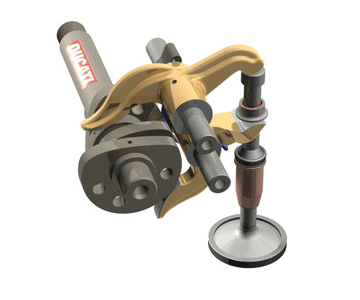1. Desmo’, how it works.
Understanding how the demo’ system works and what it does helps to understand what you are checking and why with your valve clearances and then also what you are trying to achieve by adjusting them.
I said earlier I would try to cater for everyone from the ground up, so...
Engine basics - The four stoke engine works using the phases shown in the picture below.

Image from
http://web.mit.edu
1. The intake stroke opens the inlet valve and draws in the air/fuel mixture on the pistons down stroke.
2. The compression stroke closes the valves and seals the chamber to build up pressure on the pistons up stroke.
3. Spark ignites the air/fuel mixture and the combustion forces the piston down.
4. The pistons down stroke is called the power stroke as the downward force from the combustion creates the power that turns the engine over.
5. At the end of the power stroke the exhaust valve opens for the exhaust stroke allowing the piston to force the exhaust gas out past the valve. At the end of the exhaust stroke the exhaust valve closes and the cycle starts again.
This is a very loose description of its operation but you get the idea.
Traditionally most bike engines work by using the camshafts in the cylinder head to push open the inlet and exhaust valves, when required throughout the phases of the cycle, using rockers. Then, as the cams rotate past the rockers, springs are used to force the valves closed. But, the springs take time to kick in and force the valves closed. Enter the desmodromic system...
Over the years Ducati have developed the desmo’ system which uses cams and rockers to open the inlet valves, as above, but also uses a second set of cams and rockers to mechanically close the valve when required instead of relying on the springs.

Image from
http://www.ducati.com
The image above is taken from Ducatis website and shows the components of the desmo’ system. The blue camshaft at the top centre runs through the heads and has a cam for each of the rockers. The two red rockers at the top left and top right control the openers. As the arm in the centre is pushed up by the cam the arm at the opposite end pushes down on the opener shim on the top of the valve, in yellow, and forces the valve open. As the cams turn further the opener is released and the closer cams press on the rocker arms, at the bottom centre, causing the opposite end to push against the closer shim and force the valve closed. This process then repeats throughout the combustion cycle.
Ducatidesmo.com have produced an animation that clearly shows the operation of the desmo’ system using cams to force the valve open and closed.

Image from
http://ducatidesmo.com
When the system is set up properly the cam should hold the rocker arm as flush to the closer shim as possible as it passes so that the cam seals the valve to its seat as best it can but not so tight that it causes binding. A gap is left between the opener arm and the opener shim to ensure that the valve isn't inadvertently keep the valve forced open when it isn't required to be. Over time, as the valve repeatedly hits the seat as it closes it will bed itself further into the head causing the gap to increase between the rocker arm and the closer shim and also the gap to decrease between the rocker arm and the opener shim. On Ducatis picture above you will notice a spring, again in yellow, attached to each of the closing rockers. This is to take up the last of the slack on starting and idle to ensure that the valve fully closes at low speeds if the closer gap gets bigger.